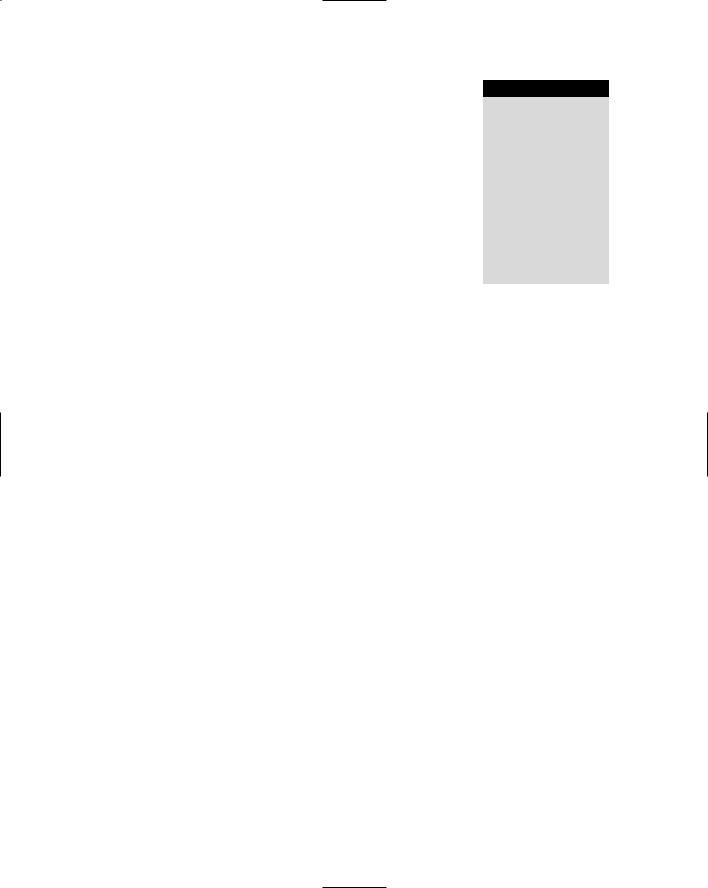
The Essential Guide to UI Design
.pdf
830References
Straub, K. (2005). “The answer you’re searching for...is “Browse”.” UI Design Newsletter. January.
Straub, K., and Valdes (2005). In Straub, K. UI Design Newsletter. January.
Straub, K. (2006). “When getting the job done isn’t enough...How insight into users process makes interactions actions more satisfying.” UI Design Newsletter. March.
Streveler, D.J. and Wasserman, A.I. (1984). “Quantitative measures of the spatial properties of screen designs.” INTERACT ‘95. Human-Computer Interaction. England.
Stromoski, R. (1993). “Fighting the futz factor.” Information Week. February 15: 55. Suhm, B., Myers, B., and Waibel, A. (1999). “Model-Based and Evaluation of
Multimodal Interactive Error Correction.” CHI 99 Conference Proceedings, 584–591. Suhm, B., Bers, J., McCarthy, D., Freeeman, B., Getty, D., Godfrey, K. and Peterson, P.
(2002) “A Comparative Study of Speech in the Call Center: Natural Language Call Routing vs. Touch-tone Menus.” ACM SIGCHI, Minneapolis, MN.
Sukaviriya, P. and Moran, L. (1990). “User interfaces for Asia.” In Designing User Interfaces for International Use, J. Nielsen (ed.). New York: Elsevier.
Sun Microsystems, Inc. (1990). OPEN LOOK Graphical User Interface Application Style Guidelines. Reading, MA: Addison-Wesley.
Sun Microsystems, Inc. (1998), www.sun.com/sunonnet/.
Tan, D. S., Czerwinski, M, and Robertson, G. (2003). “Women go with the (optical) flow.”CHI 2003 Proceedings of the Conference on Human factors in Computer Systems.
New York, ACM Press, 209-215.
Tan, W., Liu, D., Bishu, R. R., Muralidhar, A. and Meyer, J. (2001). “Design improvements through user testing.” Proceedings of the Human Factors and Ergonomics Society 45th Annual Meeting, 1181-1185.
Taylor, D. (1992). Global Software. New York: Springer Verlag.
Teevan, A., Alvarado, C., Ackerman, M. and Karger, D. (2004). “The perfect Search Engine is not enough: A Study of Orienteering Behavior in Direct Search.”
Proceedings of ACH CHI 2004, 415-422.
Thacker, P. (1987). “Tabular displays: A human factors study.” CSTG Bulletin. 14: (1)13. Thecounter.com. (2001) www.thecounter.com/stats/.
Thovtrup, H., and Nielsen, J. (1991). “Assessing the usability of a user interface standard.” Proceedings: CHI 91. 335–342.
Tindall-Ford, S., Chandler, P., and Sweller, J. (1997). “When two sensory modes are better than one,” Journal of Experimental Psychology; Applied, 3 (4)257–287.
Tinker, M. A. and Patterson, D. G. (1929). “Studies of typographical factors influencing speed of reading: Length of line.” The Journal of Applied Psychology, 13 (3), 205-219.
Tinker, M.A. (1955). “Prolonged reading tasks in visual research.” Journal of Applied Psychology, 39: 444–446.
Tripathi, P.D. (1992). “English: ‘The Chosen Tongue,’” English Today. 8 (4)3–11.
Tufte, E.R. (1983). The Visual Display of Quantitative Information. Cheshire, CT: Graphics Press.
Tullis, T. S., (1981). “An evaluation of alphanumeric, graphic, and color information displays.” Human Factors 23: 541–550.
Tullis, T. S., (1983). “Predicting the usability of alphanumeric displays.” Ph.D. diss., Rice University.
Tullis, T. S., (1993). “Is user interface design just common sense?” Proceedings of the Fifth International Conference on Human-Computer Interaction. 9–14.

References 831
Tullis, T. S., and Kodimer, M.L. (1992). “A comparison of direct-manipulation, selection, and data-entry techniques for reordering fields in a table.” Proceedings of the Human Factors Society 36th Annual Meeting, Santa Monica, CA: Human Factors Society.
Tullis, T. S., Boynton, J. L. and Hersh, H. (1995). “Readability of fonts in the windows environment.” CHI’95 Conference Proceedings-Extended Abstracts, 127-128.
Tullis, T. S., and Pons, A. (1997). “Designating required vs. optional input fields” [Extended Abstracts]. Proceedings of CHI’97, 259-260.
Tullis, T. S., Fleischman, S., McNulty, M., Cianchette, C. and Bergel, M. (2002). “An Empirical Comparison of Lab and Remote Usability Testing of Web Sites.” Usability Professionals Association Conference, Orlando, Florida.
Tullis, T. S. and Stetson, J. N. (2004). “A comparison of questionnaires for assessing website usability.” Usability Professional Association Conference, Minneapolis, MN.
Tullis, T. S. and Wood, L. (2004). “How Many Users Are Enough for a Card-Sorting Study?” Usability Professional Association Conference, Minneapolis, MN.
Tyldesley, D. A.(1988). “Employing usability engineering in the development of office projects.” Computer Journal, 31 (5), 431-436.
Uceta, F.A., Dixon, M.A., and Resnick. M.L. (1998). “Adding Interactivity to Paper Prototypes,” Proceedings of the Human Factors and Ergonomics Society 42nd Annual Meeting, 506–511.
Usability.gov/guidelines.
useit.com, “Severity Ratings for Usability Problems,” ttp://www.useit.com/papers/ heuristic/severityrating.html.
User Interface Engineering. (2001) http://world.std.com/~uieweb/tips.htm.
Van Schaik, P., and Ling, J. (2003). “Using online surveys to measure three key constructs of the quality of human-computer interaction in Web sites: Psychometric properties and implications.” International Journal of Human-Computer Studies, 59 (5), 545-567.
Vaughan, M. W. (1998). “Testing the boundaries of two user-centered design principles: Metaphors and memory load.” International Journal of Human-Computer Interaction, 10 (4), 343-360.
Verplank, B. (1988). “Designing graphical user interfaces.” Proceedings: CHI 88. May 15. Virzi, R. A. (1992). “Refining the test phase of usability evaluation: How many subjects
is enough?” Human Factors, 34, 457-468.
Virzi, R. A., Karis, D. and Sokolv, J. L. (1996). ‘Usability problem identification using both lowand high-fidelity prototypes.” Proceedings of CHI 1996, 236-243.
Vitz, P.C. (1966). “Preference for different amounts of visual complexity.” Behavioral Science, 2: 105–114.
Wainer, H. (1997). Visual revelations: Graphical tales of fate and deception from Napoleon Bonaparte to Ross Perot. New York, Springer-Verlag.
Walker, M., Takayama, L. and Landay, J. A. (2002). “High fidelity or low-fidelity, paper or computer? Choosing attributes when testing Web prototypes.” Proceedings of the Human Factors and Ergonomics Society 46th Annual Meeting, 661-665.
Walker, M.A. (1989). “Natural language in a desktop environment.” In Designing and Using Human-Computer Interfaces and Knowledge Based Systems, G. Salvendy and M.J. Smith (eds.). Amsterdam: Elsevier Science Publishers.

832References
Watts-Perotti, J. and Woods, D. D. (1999). “How experienced users avoid getting lost in large display networks.” International Journal of Human-Computer Interaction. 11 (4), 269-299.
Weber, A. (1881). “Ueber die Augenuntersuchungen in der hoheren schulen zu Darmstadt.” Abtheilung fur Gusunheitspflege, Marz. [See Tinker and Patterson, 1929].
Weinberg, B. D. (2002). “Don’t keep your Internet customers waiting too long at the (virtual) front door.” Journal of Interactive Marketing, 14 (1), 30-39.
Weinschenk, S. (1995). “Storyboarding the information process.” Session Proceedings, BFMA The 26th International Symposium on Forms and Information Systems. May 7–11, St. Louis, MO.
Weinschenk, S. (2006). UI Design Newsletter. January.
Weiss, R, Knowlton, D. and Morrison, G. R. (2002). “Principles for using animation in computer-based instruction: Theoretical heuristics for effective design.” Computers in Human Behavior, 18, 465-477.
Weiss, S. (2002). Handheld Usability. Chichester, John Wiley & Sons.
White, J.V. (1990). Color for the Electronic Age. New York: Watson-Guptill Publications. Whitelock, D. (1998). “Matching measure for measure? A route through the formative testing of multimedia science software.” In Oliver, M. (Ed.). Innovation in the
Evaluation Technology, London, University of North London.
Whiteside, J., Jones, S., Levy, P.S., and Wixon, D. (1985). “User performance with command, menu, and iconic interfaces.” Proceedings CHI 85.
Whiteside, J., Bennett, J. and Holtzblatt, K. (1988). “Usability engineering. Our experience and evolution.” In Helander, M. (Ed.), Handbook of Human-Computer Interaction, 791-817, Amsterdam: North-Holland.
Wichansky, A.M. (1986). “Legibility and user acceptance of monochrome display phospher colors.” Proceedings: International Scientific Conference: Work with Display Units. May 12–15, Stockholm, Sweden.
Wiedenbeck, S. (1999). “The use of icons and labels in an end-user application program: an empirical study of learning and retention.” Behavior and Information Technology. 18 (2).
Wikipedia.org (2006), History of the Internet. in.wikipedia.org.
Williams, J.R. (1998). “Guidelines for the Use of Multimedia in Instruction.”
Proceedings of the Human Factors and Ergonomics Society 42nd Annual Meeting, 1447–1451.
Winograd, T. (1995). “From programming environments to environments for designing.” Communications of the ACM. 38: (10)65–74.
Wopking, M., Pastoor, S., and Beldie, I.O. (1985). “Design of user guidance in videotex systems.” Proceedings of the 11th International Symposium on Human Factors in Telecommunications. Boston: Information Gatekeepers.
World Wide Web Consortium. (2001). www.w3.org.
Wright, P. (1991). “Designing and evaluating documentation for I.T. users.” In Human Factors for Informatics Usability, B. Shackel and S.J. Richardson (eds.). Cambridge U.K.: Cambridge University Press.
Wright, P., Lickorish, A., and Milroy, R. (1994). “Remember while mousing: The cognitive cost of mouse clicks.” SIGCHI Bulletin, 26: (1)41–45.

References 833
Wright, R. B. and Converse, S. A. (1992). “Method bias and concurrent protocol in software usability testing.” Proceedings of the Human Factors and Ergonomics Society 34th Annual Meeting, 1285-1289.
Wu, J. and Yuan, Y. (2003). “Improving searching and reading performance: the effect of highlighting and text color coding.” Information Management, 40, 617-637.
Xia, L. (2002). “Affect as information: the role of affect in consumer online behavior.”
Advances in Consumer Research. 29, 93-99.
Youngman, M. and Schraff, L. (1998). “Text width and margin width influences on readability of GUIs.” http//hubel.sfasu.edu/research/textmargin.html.
Yu, B. and Roh, S., (2002). “The Effect of Menu design on Information Seeking Performance and User’s Attitudes on the World Wide Web.” Journal of the American Society for Information Science and Technology, 5 (11), 923-933.
Zahn, C.T. (1971). “Graph-theoretical methods for detecting and describing gestalt clusters.” IEEE Transactions on Computers, X-20. 68–86.
Zakon.org (2006). Hobbs Internet Timeline. www.zakon.org.
Zaphiris, P. and Mtei, L. (1998). “Depth versus breadth in the arrangement of Web links.” http://otal.umd.edu/SHORE/bs04/.
Zaphiris, P. (2001). “Age Differences and the Depth-Breadth Tradeoff in Hierarchical Online Information Systems.” In C. Stephanidis (Ed.), Universal Access in HCI. Mahwah, NJ, Lawrence Erlbaum.
Zaphiris, P., Ghiawadwala, M. and Mughai (2005). “Age-centered research-based Web design guidelines.” CHI 2005 Proceedings.
Zavod, M. J. and Fulop, A. C. (2001). “Choosing input field formats for use by sales personnel.” Proceedings of the Human Factors and Ergonomics Society 45th Annual Meeting, 667-671.
Zhan, P., Bishu, R.R., and Riley, M.W. (1993). “Screen layout and semantic structure in iconic menu design.” Proceedings of the Fifth International Conference on HumanComputer Interaction.
Zheng, J., Veinott, E., Bos, N. D., Olson, J. S. and Olson, G. M. (2002). “Trust without touch: Jumpstarting long-distance trust with initial social activities.” CHI 2002 Extended Abstracts, 141-146.
Ziefle, M. (1998). “Effects of display resolution on visual performance.” Human Factors, 40 (4) 555–568.






